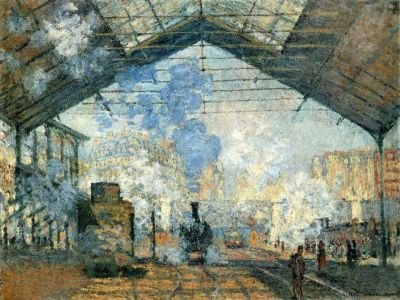
In January 1877 Claude Monet settles in Paris near the station Saint Lazare. He then paints a series of 12 paintings of different points of view representing different places of the station. This is his first series focused on a unique theme, an urban theme, a train station.
How does this work appear resolutely modern?
Enter West Station (description)
The painting represents the teeming activity of Saint Lazare station. The perspective is slightly dipped, we have a frontal view of the place. It starts from the triangular canopy to free itself in the infinite space of the vapor-laden sky. The oblique lines of the canopy meet at a central low point where the locomotive is. This line network gives depth to the board.
In the foreground, the rails that seem to come towards us invite us to travel. They intersect, are parallel and perpendicular to the steel frames of the ceiling and the canopy. In the background is a train, which enters the station with on its right a stationary car that contrasts with the hustle and bustle that surrounds it. In the distance, another train leaves for the bridge of Europe which spans the tracks. We can distinguish people on the platform.
The vapor conceals a good part of the picture and more particularly the background. Indeed, it is difficult to see the Haussmann buildings that represent part of the city of Paris. Part of the crowd on the platform is hidden by the smoke, there are vague silhouettes. In addition, the colors are very clear in the background which accentuates the effect of jamming produced by the steam and gives depth to the board. On the other hand, the colors in the foreground are rather dark.
Industrial revolution and impressionism (analysis)
Symbol of the nascent industrial revolution, the railroad developed in France from the 1820s. Soon, the railways flourished in Paris. They inspire artists who want to paint more modern subjects. Claude Monet, impressionist painter, is interested in urban subjects.
Impressionism, of which Monet is a leader, is driven by the desire to translate impressions, emotions. To do this, he paints on the ground, that is to say, he paints outside his studio, a method once again specific to the Impressionist movement.
But it is not only because he is impressionist that Monet painted the Gare Saint-Lazare. This is especially because the urban theme is very fashionable at the time. Indeed, progress fascinates the population and the artists. Monet, he seeks to diversify his inspiration by painting the urban landscape and wants to be considered as a painter of modern life like Manet or Degas. He wants to be a precursor in terms of modernity.
It is the flagship building of industrialization with one of the emblems of a booming industrial society, the architecture of glass and metal.
The Saint-Lazare Station is a manifest work of modernity. Indeed, it is modern first of all by its subject, the station, which embodies technical progress in the nineteenth century and the pictorial technique used, which is consistent with the Impressionist movement to which Monet belongs. It is representative of its time, the city of Paris in the middle of the industrial revolution with the novelty it generates in art. In this, the Saint-Lazare train station embodies the modernity.
@siavach, happy Steemian, photographer and Salsa Dancer